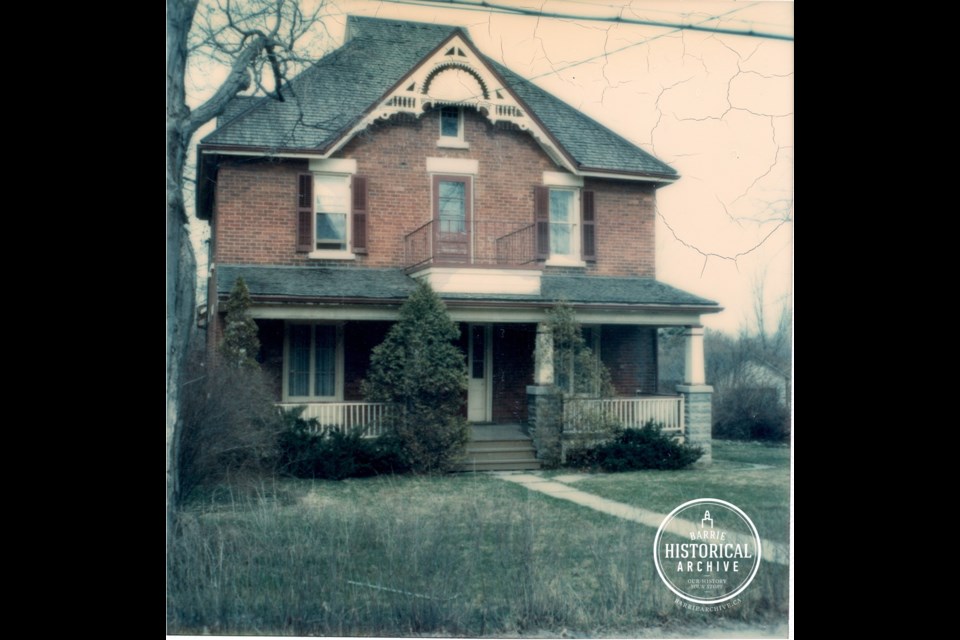This ongoing series from Barrie Historical Archive curator Deb Exel shows old photos from the collection and one from the present day, as well as the story behind them.
209 Bayfield St.
Bayfield Street was once known as Mill Road, most likely as it led to the mill on Willow Creek in Vespra Township — the first one to be built north of Lake Simcoe, about 1825.
Within two years, a grist mill and saw mill would be built, run by George Oliver and the Mairs. The little community that sprung up around these businesses was referred to as Oliver’s Mill until it was renamed Midhurst in 1864. When the mills were lost to a fire in 1887, the Barrie Electric Light Company built its generating plant on the old mill site in 1888. Barrie drew its power from Midhurst, but the demand for hydro was such that construction of a new engine house at the bottom of Bayfield Street began in 1891.
On Mill Road, renamed to Bayfield Street for Admiral Henry Wolsey Bayfield, RN, a hydrographic surveyor, records suggest the land where this solid home resides likely belonged to John Bingham in the 1850s. In fact, the area was referred to as Bingham’s Block. Bingham’s Rose Cottage, built in the 1840s, was east of Bayfield Street on what is now Davidson Street. Thomas Cundle, whose farm was located north of the house, in the village of Cundles, appears on the title in the 1870s.
John and Catherine Ormsby lived in the big house at 209 Bayfield St. in 1890. John had been born in Lindsay, moving to Bradford as a youth and then to Barrie in the mid-1870s. John was a popular guy: He was on the road first representing the Simcoe Brewery for a few years, and then travelling a route from Toronto to North Bay with the Dominion Brewing Company for about 20 years. He was the best-known and best-liked of the beer travellers, according to everyone who dealt with him. Unfortunately, a few months after retiring from life on the road, John contracted typhoid fever and died nine weeks later. He had lived at this address for about 16 years.
More occupants came and went from the brick-veneer dwelling.
In 1919, Edwin and Margaret Dibben moved into the sturdy Bayfield Street home. Edwin had been born in 1868 in Sleaford, Lincolnshire, England. His father, Edwin Sr., a distinguished Latin and Greek scholar, operated one of the short-lived private boarding and day schools, where young Edwin was educated, around 1870 — the Collegiate School for Young Gentlemen, which was in competition with the local village grammar school.
Edwin came to Canada in 1888 and began farming in Minesing. In 1907, he married Margaret Lumley. The Lumleys were thought to be the original settlers on their land in 1875, though it had been purchased from the Crown in 1859 by James Gowan. Their first dwelling was a log cabin set among the pines. The story goes that on the first night in their home, they were so worried the violent storm that was raging would bring the pine trees down on the cabin, they took their bedding to the nearest neighbour and spent the night. In the morning, the neighbour’s sons cut down the trees surrounding their home.
After farming for 32 years, Edwin made the most of his new urban life. Although retired, he was busy as an enthusiastic Conservative, serving as chairman of Ward 4 for many years, was an active member of Trinity Anglican Church and still found time to manifest his love of flowers, specializing in gladioli. The Dibbens lived at 209 Bayfield St. for about five to six years.
As time passed, many other occupants would come and go from 209 Bayfield St.
The big, boxy, Edwardian-style home, now missing a few of its architectural embellishments, continues to maintain a solemn presence as it presides over the ‘Old Mill Road.’


